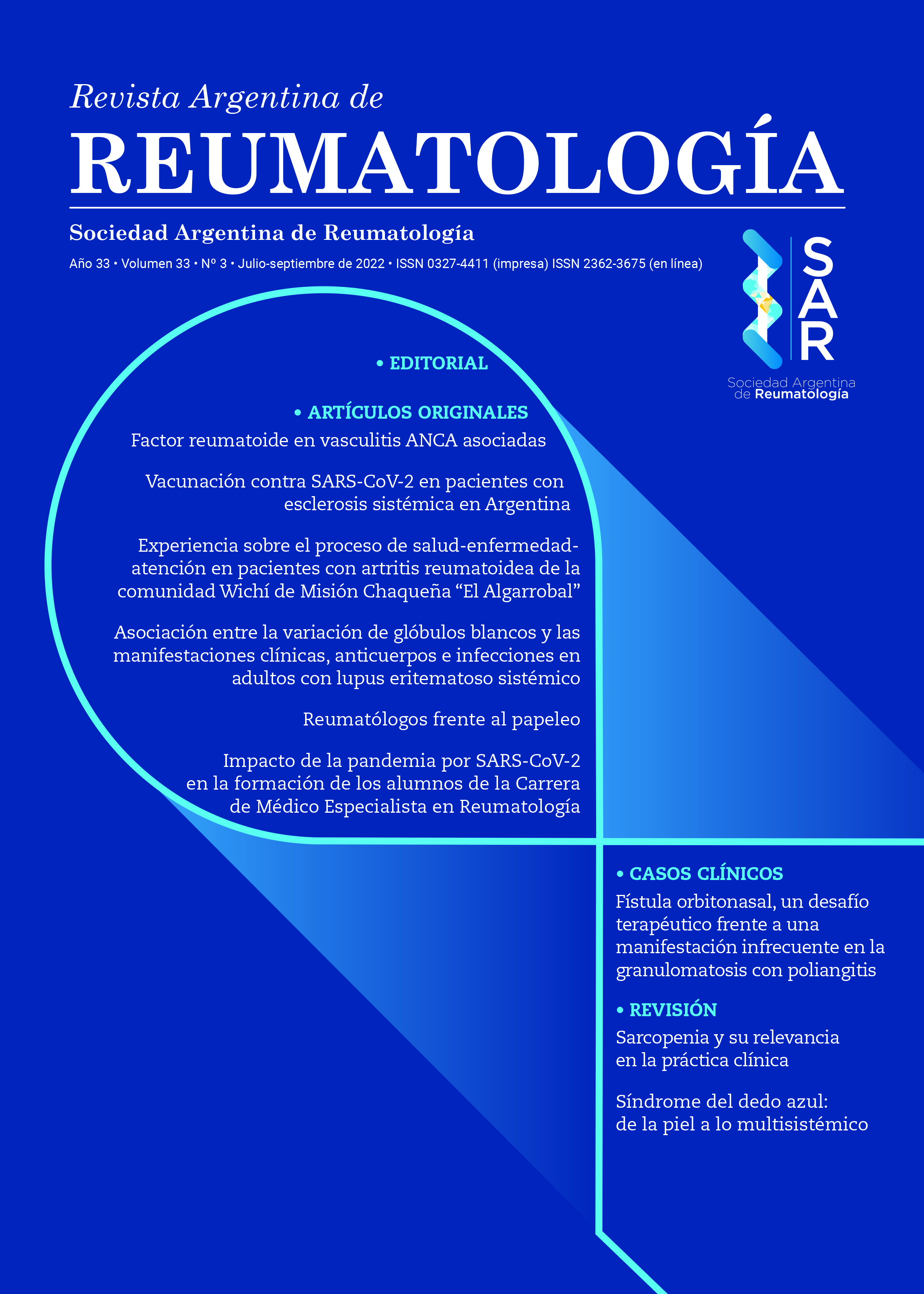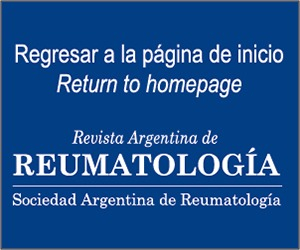Sarcopenia y su relevancia en la práctica clínica
Resumen
La sarcopenia se define como una combinación de baja fuerza y masa muscular con alteración funcional del músculo, que afecta a poblaciones de diferentes edades por diversos motivos. La prevalencia global en adultos mayores se ha estimado en 10% (IC 95%: 8-12%) en hombres y 10% (IC 95%: 8-13%) en mujeres. Recientemente ha cobrado importancia su detección en enfermedades reumáticas, particularmente las inflamatorias. En esta revisión narrativa hemos considerado: a) recomendaciones para el diagnóstico de la sarcopenia; b) herramientas útiles para la práctica clínica y la investigación; c) su relación con las enfermedades reumáticas. Según el último Consenso Europeo de Sarcopenia la búsqueda debe comenzar cuando el paciente reporta síntomas y/o signos (debilidad, lentitud al caminar, desgaste muscular, pérdida de masa muscular, etc.). Para los adultos mayores se recomienda el cuestionario SARC-F como herramienta de tamizaje. Varias pruebas establecen los puntos de corte que deben utilizarse para diagnosticar la baja fuerza muscular, la disminución en la masa muscular y la alteración en el rendimiento físico. La relevancia de diagnosticar precozmente la sarcopenia se basa en el impacto clínico, económico y social que tiene, incluyendo la funcionalidad y calidad de vida de las personas, muy importante en aquellas con enfermedades reumatológicas.Citas
I. Gil Hernández Á, Sánchez de Medina Contreras F. Tratado de Nutrición. Segunda Edición. Madrid: 2010. Editorial Médica Panamericana.
II. Cederholm T, Barazzoni R, Austin P, et al. ESPEN guidelines on definitions and terminology of clinical nutrition. Clin Nutr 2017 Feb;36(1):49-64. doi: 10.1016/j.clnu.2016.09.004.
III. Evans WJ, Campbell WW. Sarcopenia and age-related changes in body composition and functional capacity. J Nutr 1993 Feb;123(2Suppl):465-8. doi: 10.1093/jn/123.suppl_2.465.
IV. Evans WJ. What is sarcopenia? J Gerontol A Biol Sci Med Sci 1995 Nov;50 Spec No:5-8. doi: 10.1093/gerona/50a.special_issue.5.
V. Rosenberg IH. Sarcopenia: origins and clinical relevance. J Nutr 1997 May;127(5 Suppl):990S-991S. doi: 10.1093/jn/127.5.990S.
VI. Cruz-Jentoft AJ, Baeyens JP, Bauer JM, et al. European Working Group on Sarcopenia in Older People. Sarcopenia: European consensus on definition and diagnosis: Report of the European Working Group on Sarcopenia in Older People. Age Ageing 2010 Jul;39(4):412-23. doi: 10.1093/ageing/afq034.
VII. Cruz-Jentoft AJ, Bahat G, Bauer J, et al. Writing Group for the European Working Group on Sarcopenia in Older People 2 (EWGSOP2), and the Extended Group for EWGSOP2. Sarcopenia: revised European consensus on definition and diagnosis. Age Ageing 2019 Jan 1;48(1):16-31. doi: 10.1093/ageing/afy169. Erratum in: Age Ageing. 2019 Jul 1;48(4):601.
VIII. Shafiee G, Keshtkar A, Soltani A, et al. Prevalence of sarcopenia in the world: a systematic review and meta-analysis of general population studies. J Diabetes Metab Disord 2017 May 16;16:21. doi: 10.1186/s40200-017-0302-x.
IX. Morley JE. Sarcopenia: diagnosis and treatment. J Nutr Health Aging 2008 Aug-Sep;12(7):452-6. doi: 10.1007/BF02982705.
X. Godínez-Escobar K, Gallegos-De Luna C, et al. Prevalence of sarcopenia by age groups in a population of Mexico City. Arch Med Fam 2020;22(1):7-12.
XI. Cao L, Morley JE. Sarcopenia is recognized as an independent condition by an International Classification of Disease, Tenth Revision, Clinical Modification (ICD-10-CM) Code. J Am Med Dir Assoc 2016 Aug 1;17(8):675-7. doi: 10.1016/j.jamda.2016.06.001.
XII. Prado CM, Wells JC, Smith SR, et al. Sarcopenic obesity: a critical appraisal of the current evidence. Clin Nutr 2012 Oct;31(5):583-601. doi: 10.1016/j.clnu.2012.06.010.
XIII. Beaudart C, McCloskey E, Bruyère O, et al. Sarcopenia in daily practice: assessment and management. BMC Geriatr 2016 Oct 5;16(1):170. doi: 10.1186/s12877-016-0349-4.
XIV. Kalinkovich A, Livshits G. Sarcopenic obesity or obese sarcopenia: A cross talk between age-associated adipose tissue and skeletal muscle inflammation as a main mechanism of the pathogenesis. Ageing Res Rev 2017 May;35:200-221. doi: 10.1016/j.arr.2016.09.008.
XV. Newman AB, Haggerty CL, Goodpaster B, et al. Health Aging And Body Composition Research Group. Strength and muscle quality in a well-functioning cohort of older adults: the Health, Aging and Body Composition Study. J Am Geriatr Soc 2003 Mar;51(3):323-30. doi: 10.1046/j.1532-5415.2003.51105.x.
XVI. Donini LM, Busetto L, Bischoff SC, et al. Definition and diagnostic criteria for sarcopenic obesity: ESPEN and EASO Consensus Statement. Obes Facts 2022;15(3):321-335. doi: 10.1159/000521241.
XVII. Laviano A, Gori C, Rianda S. Sarcopenia, and nutrition. Adv Food Nutr Res 2014;71:101-36. doi: 10.1016/B978-0-12-800270-4.00003-1.
XVIII. Frontera WR, Hughes VA, Fielding RA, et al. Aging of skeletal muscle: a 12-yr longitudinal study. J Appl Physiol (1985) 2000 Apr;88(4):1321-6. doi: 10.1152/jappl.2000.88.4.1321.
XIX. Ibrahim K, May C, Patel HP, et al. A feasibility study of implementing grip strength measurement into routine hospital practice (GRImP): study protocol. Pilot Feasibility Stud 2016 Jun 6;2:27. doi: 10.1186/s40814-016-0067-x.
XX. Leong DP, Teo KK, Rangarajan S, et al. Prospective Urban Rural Epidemiology (PURE) Study investigators. Prognostic value of grip strength: findings from the Prospective Urban Rural Epidemiology (PURE) study. Lancet 2015 Jul 18;386(9990):266-73. doi: 10.1016/S0140-6736(14)62000-6.
XXI. Matschke V, Murphy P, Lemmey AB, et al. Skeletal muscle properties in rheumatoid arthritis patients. Med Sci Sports Exerc 2010 Dec;42(12):2149-55. doi: 10.1249/MSS.0b013e3181e304c3.
XXII. Marcora S, Lemmey A, Maddison P. Dietary treatment of rheumatoid cachexia with beta-hydroxy-beta-methylbutyrate, glutamine and arginine: a randomised controlled trial. Clin Nutr 2005 Jun;24(3):442-54. doi: 10.1016/j.clnu.2005.01.006.
XXIII. Wilkinson TJ, Lemmey AB, Jones JG, et al. Can creatine supplementation improve body composition and objective physical function in rheumatoid arthritis patients? A randomized controlled trial. Arthritis Care Res (Hoboken) 2016 Jun;68(6):729-37. doi: 10.1002/acr.22747.
XXIV. Lemmey AB, Wilkinson TJ, Clayton RJ, et al. Tight control of disease activity fails to improve body composition or physical function in rheumatoid arthritis patients. Rheumatology (Oxford) 2016 Oct;55(10):1736-45. doi: 10.1093/rheumatology/kew243.
XXV. Hull H, He Q, Thornton J, et al. iDXA, Prodigy, and DPXL dual-energy X-ray absorptiometry whole-body scans: a cross-calibration study. J Clin Densitom 2009 Jan-Mar;12(1):95-102. doi: 10.1016/j.jocd.2008.09.004.
XXVI. Landi F, Onder G, Russo A, et al. Calf circumference, frailty and physical performance among older adults living in the community. Clin Nutr 2014 Jun;33(3):539-44. doi: 10.1016/j.clnu.2013.07.013
XXVII. Beaudart C, Rolland Y, Cruz-Jentoft AJ, et al. Assessment of muscle function and physical performance in daily clinical practice. A position paper endorsed by the European Society for Clinical and Economic Aspects of Osteoporosis, Osteoarthritis and Musculoskeletal Diseases (ESCEO). Calcif Tissue Int 2019 Jul;105(1):1-14. doi: 10.1007/s00223-019-00545-w.
XXVIII. Pickering ME, Chapurlat R. Where two common conditions of aging meet: osteoarthritis and sarcopenia. Calcif Tissue Int 2020 Sep;107(3):203-211. doi: 10.1007/s00223-020-00703-5.
XXIX. Courties A, Berenbaum F, Sellam J. The phenotypic approach to osteoarthritis: a look at metabolic syndrome-associated osteoarthritis. Joint Bone Spine 2019;86:725-730. https ://doi. org/10.1016/j.jbspi n.2018.12.005.
XXX. Misra D, Fielding RA, Felson DT, et al. MOST study. Risk of knee osteoarthritis with obesity, sarcopenic obesity, and sarcopenia. Arthritis Rheumatol 2019 Feb;71(2):232-237. doi: 10.1002/art.40692.
XXXI. Cedeno-Veloz B, López-Dóriga Bonnardeauxa P, Duque G. Osteosarcopenia: una revisión narrativa. Revista Española de Geriatría y Gerontología 2019;54 (Issue 2):103-108. doi.org/10.1016/j.regg.2018.09.010.
XXXII. Nielsen BR, Abdulla J, Andersen HE, et al. Sarcopenia and osteoporosis in older people. A systematic review and meta-analysis. Eur Geriatr Med. 2018;9:419-34.
XXXIII. Gupta S, Dhillon RJS, Hasni S. Sarcopenia: a rheumatic disease? Rheum Dis Clin North Am 2018 Aug;44(3):393-404. doi: 10.1016/j.rdc.2018.03.001.
XXXIV. Teixeira Vde O, Filippin LI, Xavier RM. Mechanisms of muscle wasting in sarcopenia. Rev Bras Reumatol 2012 Mar-Apr;52(2):252-9.
XXXV. Li TH, Chang YS, Liu CW, et al. The prevalence and risk factors of sarcopenia in rheumatoid arthritis patients: A systematic review and meta-regression analysis. Semin Arthritis Rheum 2021 Feb;51(1):236-245. doi: 10.1016/j.semarthrit.2020.10.002.
XXXVI. Brance ML, Di Gregorio S, Pons-Estel BA, et al. Prevalence of sarcopenia and whole-body composition in rheumatoid arthritis. J Clin Rheumatol 2021 Sep 1;27(6S):S153-S160. doi: 10.1097/RHU.0000000000001549.
XXXVII. Kapuczinski A, Soyfoo MS, De Breucker S, Margaux J. Assessment of sarcopenia in patients with fibromyalgia. Rheumatol Int 2022 Feb;42(2):279-284. doi: 10.1007/s00296-021-04973-6.
XXXVIII. Sousa AS, Guerra RS, Fonseca I, et al. Financial impact of sarcopenia on hospitalization costs. Eur J Clin Nutr 2016 Sep;70(9):1046-51. doi: 10.1038/ejcn.2016.73.
XXXIX. Tsekoura M, Kastrinis A, Katsoulaki M, et al. Sarcopenia and its impact on quality of life. Adv Exp Med Biol 2017;987:213-218. doi: 10.1007/978-3-319-57379-3_19.
XL. Malmstrom TK, Morley JE. SARC-F: a simple questionnaire to rapidly diagnose sarcopenia. J Am Med Dir Assoc 2013 Aug;14(8):531-2. doi: 10.1016/j.jamda.2013.05.018.
XLI. Tournadre A, Vial G, Capel F, et al. Sarcopenia. Joint Bone Spine 2019 May;86(3):309-314. doi: 10.1016/j.jbspin.2018.08.001.
XLII. Mijnarends DM, Luiking YC, Halfens RJG, et al. Muscle, health and costs: a glance at their relationship. J Nutr Health Aging 2018;22(7):766-773. doi: 10.1007/s12603-018-1058-9.
XLIII. Bischoff-Ferrari HA, Orav JE, Kanis JA, et al. Comparative performance of current definitions of sarcopenia against the prospective incidence of falls among community-dwelling seniors age 65 and older. Osteoporos Int 2015 Dec;26(12):2793-802. doi: 10.1007/s00198-015-3194-y.
XLIV. Schaap LA, van Schoor NM, Lips P, Visser M. Associations of sarcopenia definitions, and their components, with the incidence of recurrent falling and fractures: The Longitudinal Aging Study Amsterdam. J Gerontol A Biol Sci Med Sci. 2018 Aug 10;73(9):1199-1204. doi: 10.1093/gerona/glx245.
XLV. Bone AE, Hepgul N, Kon S, Maddocks M. Sarcopenia and frailty in chronic respiratory disease. Chron Respir Dis 2017 Feb;14(1):85-99. doi: 10.1177/1479972316679664.
XLVI. Chang KV, Hsu TH, Wu WT, et al. Association between sarcopenia and cognitive impairment: a systematic review and meta-analysis. J Am Med Dir Assoc 2016 Dec 1;17(12): 1164.e7-1164.e15. doi: 10.1016/j.jamda.2016.09.013.
XLVII. Ibrahim K, May C, Patel HP, et al. A feasibility study of implementing grip strength measurement into routine hospital practice (GRImP): study protocol. Pilot Feasibility Stud. 2016 Jun 6;2:27. doi: 10.1186/s40814-016-0067-x.
XLVIII. Leong DP, Teo KK, Rangarajan S, et al. Prospective Urban Rural Epidemiology (PURE) Study investigators. Prognostic value of grip strength: findings from the Prospective Urban Rural Epidemiology (PURE) study. Lancet. 2015 Jul 18;386(9990):266-73. doi: 10.1016/S0140-6736(14)62000-6.
XLIX. Schaap LA, Koster A, Visser M. Adiposity, muscle mass, and muscle strength in relation to functional decline in older persons. Epidemiol Rev 2013;35:51-65. doi: 10.1093/epirev/mxs006.
L. Biolo G, Ciocchi B, Lebenstedt M, et al. Sensitivity of whole-body protein synthesis to amino acid administration during short-term bed rest. J Gravit Physiol 2002 Jul;9(1): P197-8.
LI. Paddon-Jones D, Sheffield-Moore M, Zhang XJ, et al. Amino acid ingestion improves muscle protein synthesis in the young and elderly. Am J Physiol Endocrinol Metab 2004 Mar;286(3):E321-8. doi: 10.1152/ajpendo.00368.2003.
LII. Koca I, Savas E, Ozturk ZA, et al. The evaluation in terms of sarcopenia of patients with fibromyalgia syndrome. Wien Klin Wochenschr 2016 Nov;128(21-22):816-821. doi: 10.1007/s00508-015-0821-8.
LIII. Janssen I, Heymsfield SB, Ross R. Low relative skeletal muscle mass (sarcopenia) in older persons is associated with functional impairment and physical disability. J Am Geriatr Soc 2002 May;50(5):889-96. doi: 10.1046/j.1532-5415.2002.50216.x.
LIV. Miller J, Wells L, Nwulu U, et al. Validated screening tools for the assessment of cachexia, sarcopenia, and malnutrition: a systematic review. Am J Clin Nutr 2018 Dec 1;108(6):1196-1208. doi: 10.1093/ajcn/nqy244.
LV. Abellan van Kan G, André E, Bischoff Ferrari HA, et al. Carla task force on sarcopenia: propositions for clinical trials. J Nutr Health Aging 2009 Oct;13(8):700-7. doi: 10.1007/s12603-009-0200-0.
LVI. Cruz-Jentoft AJ, Romero-Yuste S, Chamizo Carmona E, Nolla JM. Sarcopenia, immune-mediated rheumatic diseases, and nutritional interventions. Aging Clin Exp Res 2021 Nov;33(11):2929-2939. doi: 10.1007/s40520-021-01800-7.
LVII. Santo RCE, Fernandes KZ, Lora PS, et al. Prevalence of rheumatoid cachexia in rheumatoid arthritis: a systematic review and meta-analysis. J Cachexia Sarcopenia Muscle 2018 Oct;9(5):816-825. doi: 10.1002/jcsm.12320.
LVIII. Hax V, do Espírito Santo RC, Dos Santos LP, et al. Practical screening tools for sarcopenia in patients with systemic sclerosis. PLoS One. 2021 Jan 22;16(1):e0245683. doi: 10.1371/journal.pone.0245683.
LIX. Landi F, Camprubi-Robles M, Bear DE, et al. Muscle loss: The new malnutrition challenge in clinical practice. Clin Nutr. 2019 Oct;38(5):2113-2120. doi: 10.1016/j.clnu.2018.11.021.
LX. Sanz-Paris A, Camprubi-Robles M, López-Pedrosa JM, et al. Role of oral nutritional supplements enriched with β-hydroxy-β-methylbutyrate in maintaining muscle function and improving clinical outcomes in various clinical settings. J Nutr Health Aging 2018;22(6):664-675. doi: 10.1007/s12603-018-0995-7.
LXI. Holeček M. Beta-hydroxy-beta-methylbutyrate supplementation and skeletal muscle in healthy and muscle-wasting conditions. J Cachexia Sarcopenia Muscle 2017 Aug;8(4):529-541. doi: 10.1002/jcsm.12208.
LXII. Cieślak D, Zarobkiewicz M, Nieradko-Iwanicka B. β-hydroxy-β-methylbutyrate (HMB) supplementation in prevention and treatment of elderly sarcopenia. Journal of Education, Health and Sport 2018;8(10):41-49. eISNN 2391-8306. doi: 10.5281/zenodo.1415425
LXIII. Tournadre A, Vial G, Capel F. Sarcopenia. Joint Bone Spine 2019;86. 10.1016/j.jbspin.2018.08.001.
LXIV. Cruz-Jentoft AJ, Landi F, Schneider SM, et al. Prevalence of and interventions for sarcopenia in ageing adults: a systematic review. Report of the International Sarcopenia Initiative (EWGSOP and IWGS). Age Ageing 2014 Nov;43(6):748-59. doi: 10.1093/ageing/afu115.
LXV. Lemmey AB, Marcora SM, Chester K, et al. Effects of high-intensity resistance training in patients with rheumatoid arthritis: a randomized controlled trial. Arthritis Rheum 2009 Dec 15;61(12):1726-34. doi: 10.1002/art.24891.
LXVI. Peterson MD, Sen A, Gordon PM. Influence of resistance exercise on lean body mass in aging adults: a meta-analysis. Med Sci Sports Exerc 2011 Feb;43(2):249-58. doi: 10.1249/MSS.0b013e3181eb6265.
LXVII. Hein TR, Peterson L, Bartikoski BJ, et al. The effect of disease-modifying anti-rheumatic drugs on skeletal muscle mass in rheumatoid arthritis patients: a systematic review with meta-analysis. Arthritis Res Ther 2022 Jul 19;24(1):171. doi: 10.1186/s13075-022-02858-y.
LXVIII. Gruenewald DA, Matsumoto AM. Testosterone supplementation therapy for older men: potential benefits and risks. J Am Geriatr Soc. 2003 Jan;51(1):101-115. doi: 10.1034/j.1601-5215.2002.51018.x.
LXIX. Snyder PJ, Peachey H, Berlin JA, Hannoush P, Haddad G, Dlewati A, Santanna J, Loh L, Lenrow DA, Holmes JH, Kapoor SC, Atkinson LE, Strom BL. Effects of testosterone replacement in hypogonadal men. J Clin Endocrinol Metab 2000 Aug;85(8):2670-7. doi: 10.1210/jcem.85.8.6731. PMID: 10946864.
LXX. Ferrucci L. The Baltimore Longitudinal Study of Aging (BLSA): a 50-year-long journey and plans for the future. J Gerontol A Biol Sci Med Sci. 2008 Dec;63(12):1416-9. doi: 10.1093/gerona/63.12.1416.
Derechos de autor 2022 A nombre de los autores. Derechos de reproducción: Sociedad Argentina de Reumatología

Esta obra está bajo licencia internacional Creative Commons Reconocimiento-NoComercial-SinObrasDerivadas 4.0.






